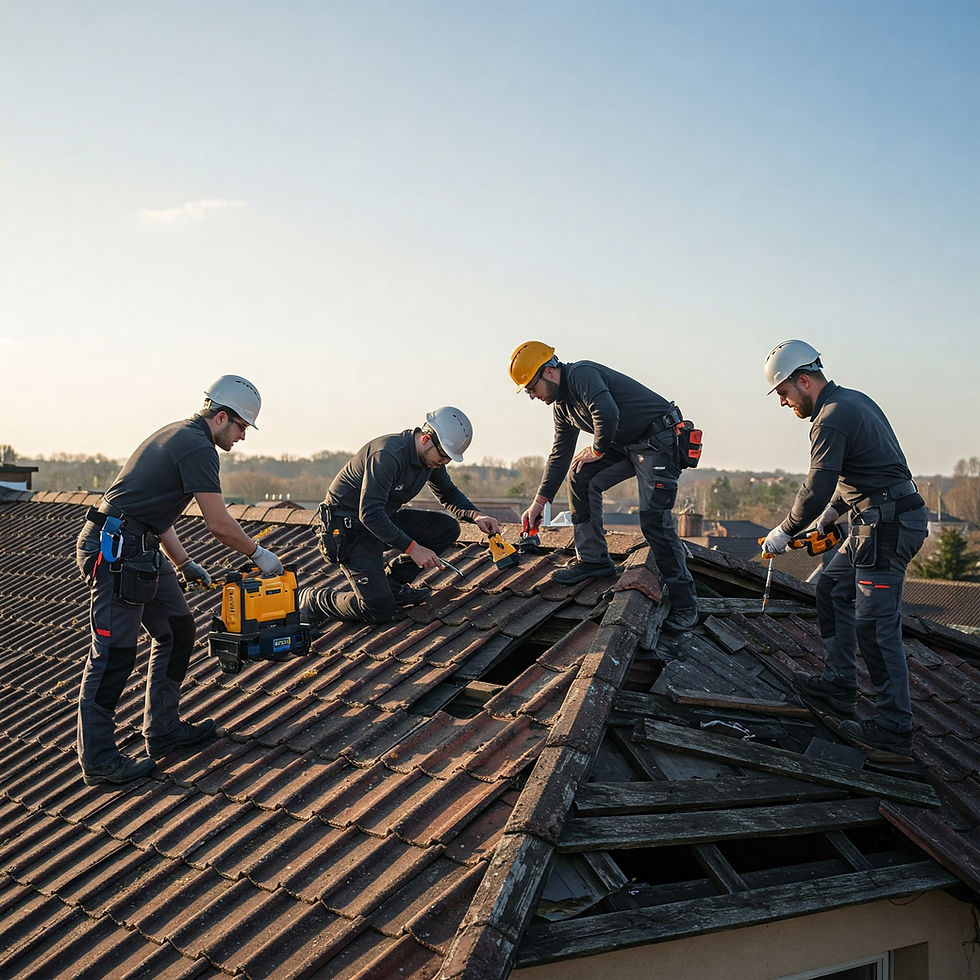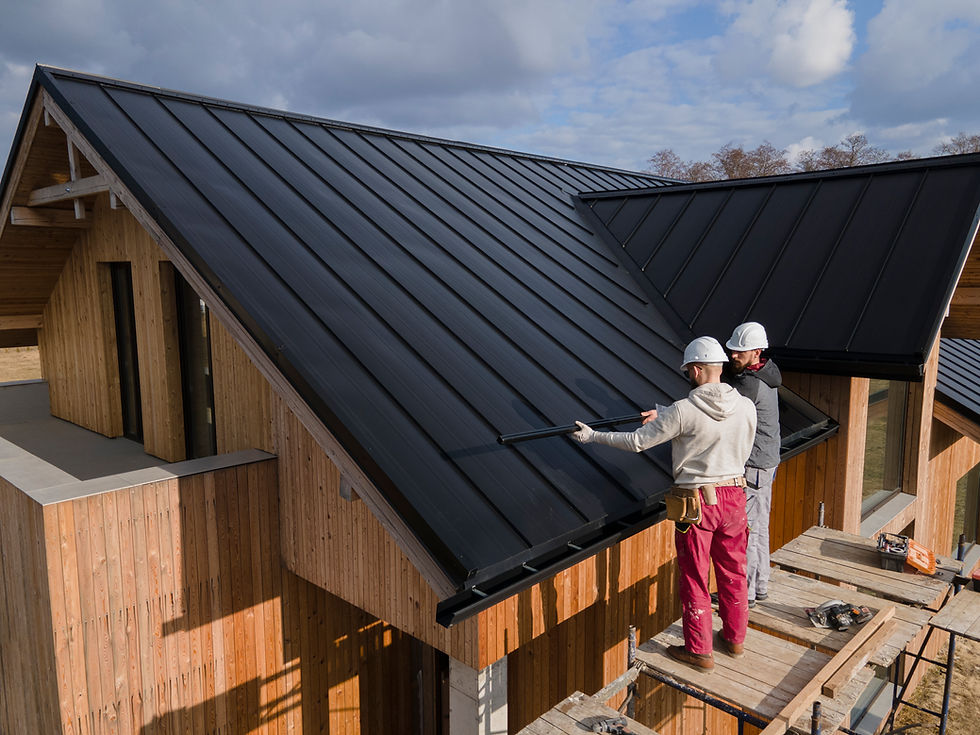Eco-Friendly Roof Repairs: Sustainable Materials That Last
- Adam Smith
- Jul 1
- 5 min read
Homeowners across the UK are becoming more environmentally conscious. From energy-efficient windows to solar panels, sustainable living is now a priority. However, one often overlooked area of sustainable improvement is the roof.
When it's time for roof repairs, opting for eco-friendly solutions can save money, reduce environmental impact, and improve energy efficiency. In this blog, we’ll explore sustainable materials that make roof repairs both practical and green. We’ll also highlight how working with the right local roofer or roofing contractor ensures the longevity of your roofing system.
Why Eco-Friendly Roof Repairs Matter
Traditional roofing materials can harm the environment. Asphalt shingles, for example, contribute heavily to landfill waste. Additionally, many conventional repair processes use chemical-based adhesives and coatings that release toxins into the air.
Eco-friendly roof repairs focus on using sustainable, recyclable, and energy-efficient materials. These not only reduce your carbon footprint but also lower long-term maintenance and energy costs. Furthermore, they help protect your home from extreme weather while being kind to the environment.

Characteristics of Sustainable Roofing Materials
Not every "green" material is equal. To ensure you're making an eco-conscious choice, look for materials that are:
Durable: Longer life spans mean fewer replacements and less waste.
Recyclable: At the end of their life cycle, they shouldn't end up in landfills.
Energy-efficient: They should help insulate your home, reducing heating and cooling demands.
Sourced responsibly: Materials should come from renewable or low-impact sources.
Now, let’s take a closer look at the best eco-friendly options for both flat roofing and pitched roofing.
Sustainable Materials for Flat Roofing
Flat roofs are common in urban homes and commercial buildings. Here are eco-friendly materials suited for flat roofing systems:
1. Green Roof Systems
These involve planting vegetation on your rooftop. Not only do they look stunning, but they also:
Provide natural insulation
Absorb rainwater, reducing runoff
Support biodiversity
Improve air quality
Green roofs require structural support and drainage planning, so it's best to consult an experienced roofing contractor.
2. EPDM Rubber Roofing (Recycled Option)
EPDM (ethylene propylene diene monomer) is a synthetic rubber roofing membrane. Modern versions are made from recycled materials and are highly durable, lasting up to 50 years.
They are:
Resistant to UV rays
Easy to install and maintain
Lightweight, reducing structural stress
When installed by a certified local roofer, EPDM becomes a reliable and eco-conscious solution for roof repairs.
3. Cool Roof Coatings
Cool roof coatings reflect more sunlight and absorb less heat. Many of these coatings are now made from sustainable or non-toxic substances. This makes them excellent for lowering indoor temperatures and reducing the need for air conditioning.
Sustainable Materials for Pitched Roofing
For homeowners with pitched roofs, several eco-friendly materials offer durability and aesthetic appeal.
1. Clay and Slate Tiles
Natural clay and slate tiles are among the most durable roofing materials. Their lifespan can exceed 100 years when installed properly.
Key benefits:
100% natural and recyclable
Fire-resistant
Require minimal maintenance
Though heavier and costlier, their longevity justifies the investment. A skilled roofing contractor ensures secure fitting and proper alignment.
2. Recycled Metal Roofing
Metal roofs made from recycled aluminium or steel are ideal for sustainable roof repairs. They reflect solar heat and reduce cooling costs during summer.
Benefits include:
Long life span (40–70 years)
Fully recyclable at the end of life
Lightweight and quick to install
Opt for painted or coated varieties that use low-VOC finishes to enhance energy performance.
3. Wood Shingles and Shakes (From FSC-Certified Sources)
Wooden roofing materials, when sourced from FSC-certified forests, offer a rustic, natural look. Cedar is a popular choice due to its resistance to decay.
Advantages:
Biodegradable
Renewable material
Moderate insulation properties
However, they do require regular maintenance. Choose pressure-treated or naturally resistant varieties to prolong their life.
Additional Eco-Friendly Roofing Options
1. Solar Shingles
These are photovoltaic cells disguised as traditional shingles. They generate electricity while protecting your home, combining the benefits of solar panels and roof tiles.
Ideal for eco-conscious homeowners looking to reduce grid dependency. Solar shingles work best when installed during a full roof replacement, although some versions can be added during roof repairs.
2. Recycled Shingle Roofing
Made from rubber, plastic, or wood fibre, these shingles replicate the look of traditional materials while being sustainable. They are often made from post-consumer waste like tyres or plastic containers.
They offer:
Excellent durability
UV resistance
A lighter ecological footprint
How Eco-Friendly Roof Repairs Save Money
While sustainable materials may seem more expensive at first glance, they offer long-term cost benefits:
Lower utility bills due to improved insulation
Fewer repairs due to material durability
Tax credits or government incentives in certain regions
Higher property value due to energy efficiency features
An experienced roofing contractor can help you calculate the return on investment (ROI) for eco-friendly roofing options.
Working With the Right Roofing Services Provider
Choosing a reliable roofing services provider is essential to getting the most out of eco-friendly materials. Here’s what to look for:
Experience with green building practices
Knowledge of local building codes
Use of certified sustainable materials
Transparent pricing and warranties
Ask for references, check reviews, and ensure the local roofer is licensed and insured.
When to Consider a Roof Replacement
There are times when roof repairs are no longer sufficient. If your roof:
Leaks constantly
Has widespread damage
Is over 25 years old
Then, a complete roof replacement with sustainable materials is a smart move. Combining high-quality materials with expert installation enhances the lifespan and performance of your new roof.
A professional roofing contractor will assess the condition of your roof and recommend whether repairs or full replacement is the more cost-effective and sustainable choice.
Eco-Friendly Roofing: Maintenance Tips
Once your green roof is in place, proper maintenance will ensure it lasts for decades. Follow these simple steps:
Inspect regularly: Check for damage after storms.
Clean debris: Remove leaves or dirt that might trap moisture.
Fix issues promptly: Address minor leaks or damage quickly to avoid larger problems.
Recoat when needed: For systems like EPDM or cool roof coatings, recoating extends life.
Regular maintenance reduces the need for frequent roof repairs, saving money and preventing waste.
Conclusion
Eco-friendly roof repairs are more than just a trend—they’re a smart investment in your home and the planet. By choosing sustainable materials and working with experienced professionals, you’ll enjoy long-lasting protection, improved energy efficiency, and peace of mind knowing you’re doing your part for the environment.
Whether you have a flat roofing system or a pitched roofing design, there's a green solution to suit your needs. Sustainable options like green roofs, recycled metal tiles, solar shingles, and clay tiles provide performance without compromising the environment. Combine these with expert roofing services to make the most of your investment.
As awareness grows, more homeowners are seeking greener building practices. By making informed decisions today, you’re contributing to a cleaner, more responsible tomorrow.



Comments